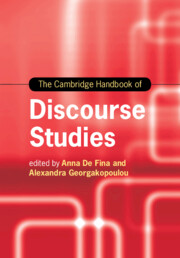Book contents
- The Cambridge Handbook of Discourse Studies
- Cambridge Handbooks in Language and Linguistics
- The Cambridge Handbook of Discourse Studies
- Copyright page
- Contents
- Figures
- Tables
- Contributors
- Preface
- Part I (Con)Textualizing Discourses
- Part II Perspectives and Modes of Analysis
- Part III Discourse Materialities and Embodiment
- Part IV (Trans)Locations and Intersections
- Part V Ethics, Inequality and Inclusion
- Part VI Discourses, Publics and Mediatization
- 27 The Critical Analysis of Genre and Social Action
- 28 Rhetorics, Discourse and Populist Politics
- 29 The Discourses of Money and the Economy
- 30 Corporate Discourse
- 31 Mediatized Communication and Linguistic Reflexivity in Contemporary Public and Political Life
- 32 Discourse Analysis and Digital Surveillance
- Index
- References
27 - The Critical Analysis of Genre and Social Action
from Part VI - Discourses, Publics and Mediatization
Published online by Cambridge University Press: 28 September 2020
- The Cambridge Handbook of Discourse Studies
- Cambridge Handbooks in Language and Linguistics
- The Cambridge Handbook of Discourse Studies
- Copyright page
- Contents
- Figures
- Tables
- Contributors
- Preface
- Part I (Con)Textualizing Discourses
- Part II Perspectives and Modes of Analysis
- Part III Discourse Materialities and Embodiment
- Part IV (Trans)Locations and Intersections
- Part V Ethics, Inequality and Inclusion
- Part VI Discourses, Publics and Mediatization
- 27 The Critical Analysis of Genre and Social Action
- 28 Rhetorics, Discourse and Populist Politics
- 29 The Discourses of Money and the Economy
- 30 Corporate Discourse
- 31 Mediatized Communication and Linguistic Reflexivity in Contemporary Public and Political Life
- 32 Discourse Analysis and Digital Surveillance
- Index
- References
Summary
The concept of discourse has always been at the core of critical analysis in the field of discourse studies. To some extent this is explained by the connection between discourses, in a Foucauldian sense, and representations of, for instance, power relations, gender and social injustices – all in need of critical analysis. However, in research on organizational discourse, the object for critique can be the transformations of social actions within organizations rather than, for example, unequal representations (in texts). There is a well-established link between social actions and genres: genres are (or are at least part of) social actions. The overarching aim of this chapter is to discuss how genre-oriented analysis can complement other types of analysis in the broader field of critical discourse studies, and to offer critical understandings more directly related to social actions. The chapter gives an overview of two approaches to the critical analysis of genre: critical discourse analysis (CDA) and critical genre analysis (CGA). From the perspective of methodology, the chapter responds to calls for a social and affordance-driven multimodal critical discourse studies by offering a number of qualitative concepts for analyzing the genre aspects of multimodal texts. Analytical examples come from interrelated genres such as “vision and values,” “core values” and “platforms and values” from state agencies and universities in, above all, Sweden and the United States. In the context of public authorities, these genres are to be considered as emerging genres, which allows for a specific type of critical inquiry: Which are the changing social actions that these genres are part of? Are they related to internal control or to external communication and market-oriented “branding” of the public authority?
Keywords
- Type
- Chapter
- Information
- The Cambridge Handbook of Discourse Studies , pp. 601 - 621Publisher: Cambridge University PressPrint publication year: 2020
References
Further Reading
In this book, Bhatia introduces, discusses and positions CGA (primarily in relation to CDA).
This edited volume contains a number of genre-oriented studies of political communication, including the analysis of meetings by Wodak (2013) and a chapter by Krzyżanowski (2013) on policy genres in the European Union.
This is one of the more accessible introductions to Fairclough’s uses of genre within his CDA framework.
The volume introduces the New Rhetoric and also contains Miller’s (1984) classic paper “Genre as Social Action.”
This book presents the foundations and a number of applications of Sydney school genre analysis.
The chapter describes how genre is perceived within the discourse-historical approach (DHA).
This chapter gives a good overview of the New Rhetoric, the Sydney school and genre analysis in ESP.
Swales’ book is a key reading regarding genre analysis in ESP.
This introduces van Leeuwen’s multimodal genre analysis.
References
- 1
- Cited by



